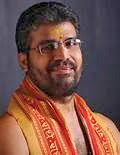The Process of Yoga 2.1: Swami Krishnananda
===============================================================
============================================================
Wednesday, January 19, 2022. 06:00. AM.
Chapter 2: The Structure of the Universe-1.
===============================================================
Yesterday we were trying to distinguish between the formal relationships among things in terms of social ethics and personal etiquette on a utilitarian basis on one side and, on the other side, a scientific relationship that seems to be there among things. This analysis carries us to the larger question of the structure of the universe – how the world is functioning at all.
What is the constitution of the universe? We have constitutions of our government – there is a president, a prime minister, a cabinet, and there is a system of state government under which we have various officials representing the Centre, functioning in a harmonious manner in consonance with the system established in the form of the central constitution. Likewise, we have a constitution of the universe, a law laid down by the Centre, in accordance with which the whole of creation is to function – not chaotically or discordant with the central mode, but in concordance and in harmony with the central system originally laid down by an enactment of cosmical principles.
On one side of the picture, we see a vast world before us. We have a universe of physical matter which is supposed to be constituted of the mahabhutas, or the five elements – the earth principle, water principle, fire principle, air principle and ether principle. These five elements are before us as large objects of perception, called mahabhutas, vast objects. They are spread out everywhere. Wherever we look, we have before us earth, water, fire, air and ether. Most of the objects of the world are also constituted of the earth principle. Anything that is hard to the touch may be said to have the earth principle preponderating in it. According to a principle of permutation and combination of the elements, each element is supposed to have a certain fraction of other elements also within it, so that we do not have a pure earth principle, a pure water principle, a pure fire principle, and so on. Every element has other elements mixed with it in some proportion. Nevertheless, with all these permutations and combinations, the essential elements are only five.
But, the question is not answered merely by an enunciation of these five elements because all these elements stand in the position of objects of perception, and objects naturally have to hang on a subject of perception. There should be a sort of intimate connection between what is seen and the principle of seeing. It is impossible to posit the existence of even objects such as the five elements unless there is a proof for it. The proof for the existence of an object cannot be the object itself because the object does not prove its own existence. Something is brought in as a proof for the existence of objects. How do we know that the world exists? The world itself is not the proof. The proof is always a logical deduction consciously arrived at by processes other than what can be called the objective. A stone is not a proof of its own existence. The proof of the stone's existence is its being perceived.
Generally, we do not believe in the existence of God because God is not perceived. As something is not seen, we conclude it is not there. If something cannot be seen, cannot be heard, cannot be smelt, cannot be tasted, cannot be touched, what conclusion can we arrive at in regard to it? Perhaps it does not exist. The element of God does not exist, so we can deny His existence very easily inasmuch as there is no sensory proof for the existence of any such principle. If the world is to exist, it has to be sensorily proved. The world exists because it can be seen with the eyes, its sound can be heard by the ears, it can be tasted, it can be smelt, and it can be touched by the tactile sense. So the proof of the existence of the world is not the world itself because if we can conclude that the world exists from its own point of view taken independently, then we can say anything exists from its own point of view, whether it is seen or not.
To be continued .....
===============================================================








Comments